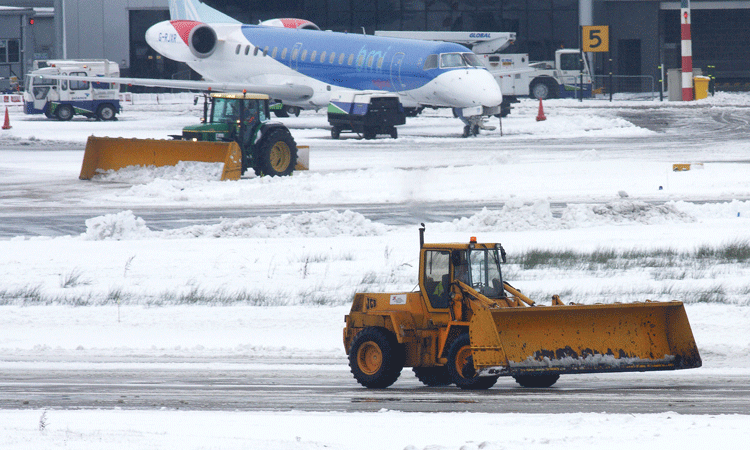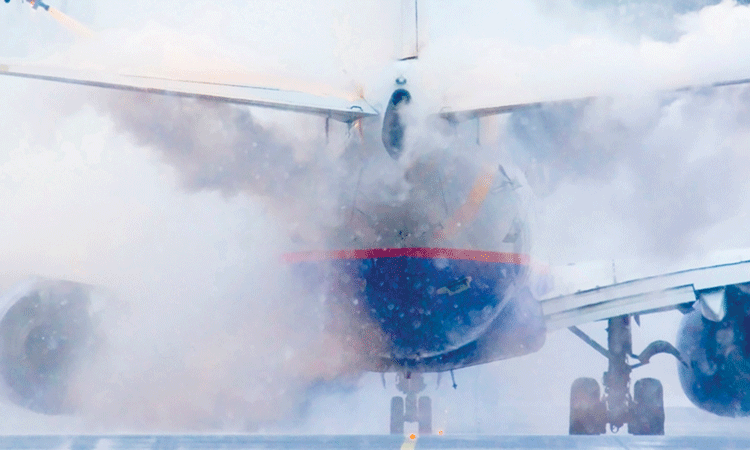Always be prepared: The importance of forecasting during winter
- Like
- Digg
- Del
- Tumblr
- VKontakte
- Buffer
- Love This
- Odnoklassniki
- Meneame
- Blogger
- Amazon
- Yahoo Mail
- Gmail
- AOL
- Newsvine
- HackerNews
- Evernote
- MySpace
- Mail.ru
- Viadeo
- Line
- Comments
- Yummly
- SMS
- Viber
- Telegram
- Subscribe
- Skype
- Facebook Messenger
- Kakao
- LiveJournal
- Yammer
- Edgar
- Fintel
- Mix
- Instapaper
- Copy Link
Posted: 21 January 2014 | David Gibbs | No comments yet
David Gibbs, the Met Office’s Aviation Business Manager, explores the role of forecasts in helping to ensure airports and airlines remain open during challenging winter weather.


Winter is a challenging time for airport and airline operations, with winter weather often causing delays, diversions and disruption – putting a strain on operating schedules and causing significant inconvenience to passengers and staff resources. With the continuing increase in air traffic volume and demand for increased airfield and airspace capacity, the need for accurate weather information is critical to help mitigate weather-related disruption.
Airports and airlines have access to a wide range of weather information which the Met Office provides on behalf of the UK Government, the CAA and ICAO, such as our ICAO Annex 3 aviation services – TAFs, trends and warnings. Our operational forecasting for NATS helps to minimise the impact of weather on aircraft across UK airspace, and ongoing collaboration work is helping to enhance science and deliver time-based separation and runway occupancy times.
There are also some less obvious areas where forecasts help to ensure airports and airlines operate as efficiently as possible during challenging winter weather. For example, by working closely with national providers, forecasts help to keep transport infrastructure moving in order to reduce travel issues for passengers and staff accessing airports. Also, making quality weather information easily available via social media allows the public and airport workers to be well briefed on the latest weather outlook, and working with the Government during significant weather events enables consistent messages across all sectors. Although these activities are aimed at various sectors – public, private and business – they still play a part in helping the aviation industry deal with adverse weather conditions.
The Met Office’s specialist aviation weather forecasting services can produce dramatic benefits and cost savings for both large international hubs and smaller airports. For example, at London’s Heathrow, Met Office forecasters work with operational staff on-site and around the clock every day of the year. This gives the forecasters a thorough understanding of Heathrow’s operations and thresholds and means that Heathrow staff can easily obtain the latest information and forecast graphics to discuss the probabilities attached to any risk. While on-site forecasters may not be the solution for every airport, all airports can benefit from intuitive, one-stop-shop web services and 24/7/365 access to specialist aviation forecasters who understand the specific issues which impact airport and airline operations.
Ultimately, access via appropriate channels to the best weather forecasts and information for destinations and departures gives operations teams the confidence to make more informed decisions on diversions, aircraft and runway de-icing and resource planning to minimise disruption, and provides justification for potential delays and associated increased costs.
Accurate forecasting
In order to provide these forecasts it is critical that we have precise details on what the weather is doing now – that means having highly accurate observations from all over the globe. Without these timely and precise meteorological observations, forecasts can be severely degraded, but achieving the necessary standards and accuracy of global observations required presents a significant technological challenge.
In order to predict weather conditions in the future we need to observe and understand the current state of the atmosphere and then apply the understanding of the physical processes that governs changes in temperature, wind and cloud over time. Therefore creating a coherent picture of the atmosphere is the starting point for any forecast.
To describe the changes of the atmosphere over time we need to solve complex mathematical equations, which are constantly refined based on the actual measurements of the atmosphere in specific conditions.
The Met Office’s Numerical Weather Prediction model creates a grid of evenly-spaced points across the globe and forecasts the atmosphere based on the grid of points spanning the globe. This requires an enormous number of calculations to be carried out, which in turn requires a vast computing resource. The Met Office’s supercomputer is capable of making 125 trillion calculations per second. Its power allows it to take in hundreds of thousands of weather observations from all over the world, which it then takes as a starting point for running an atmospheric model containing more than one million lines of code!


Understanding meteorological data
Our understanding of the atmosphere is continually improving, and as a result our forecasts are becoming more and more refined. Similarly, the role of meteorology information is constantly evolving to best meet and assist with the latest challenges and developments in the aviation industry; bringing the benefits of the most advanced science and technology to the sector.
This has enabled us to improve our forecasts about the risk of high-impact weather, which benefits airports by enabling them to better understand the uncertainty associated with any upcoming severe weather events, and to manage their weather-related risks more effectively.
As well as helping to increase the accuracy of forecasts, advances in technology have led to the development of products designed to make weather information more accessible to the aviation community; enabling the presentation of weather information to staff aligned to their operational thresholds. The result is outcome-based guidance, such as our Red/Amber/Green (RAG) alerts, which allow quick decisions to be made with confidence and without the need to study complex meteorological data.
The use of probabilistic forecasts also helps to align weather impact guidance to operational thresholds, which is an area we are focusing on with our industry colleagues. Advances in supercomputer power directly benefit probabilistic forecasting by providing the necessary capability to generate the data processing required to produce the high number of forecast scenarios which determine the relative probabilities of forecast conditions.
Probabilistic forecasts and outcome-based guidance are particularly well suited within an Airport Collaborative Decision Making (A-CDM) environment. Our Aviation Meteorology Services Portal is already attracting real interest as a major contributor to help all users within an A-CDM community share the ‘single vision’ of current and forecast weather conditions. A similar interest is being shown in having greater access to probabilistic forecasts. As meteorological guidance helps to ease the impact of adverse conditions on so many tasks (including airframe and runway de-icing, low visibility procedures, runway capacity, runway maintenance, flight planning and snow clearance), it is easy to see how a ‘single vision’ will aid airport communities to work in a more integrated manner.
Airports reap the rewards
High quality forecasts help minimise the impacts of extreme weather conditions, both in advance of and during extreme weather conditions, which benefits both large hubs and small airports.
Larger airports find a seamless weather forecasting system highly beneficial, as it enables their teams to monitor the weather conditions for specific activities. By receiving alerts for severe weather that could cause major disruptions (e.g. heavy snowfall), operations staff are able to make quick decisions with confidence and place resources effectively in advance of any disruption.
There are benefits to be reaped at small airports too, such as the UK’s Newquay Airport located on Cornwall’s north coast. Here, the operations team saved money by using the Met Office’s OpenRunway® service, which provides weather information in one place and alerts the team to changing weather conditions; enabling the airport to plan ahead. By being winter weather prepared, the airport has used significantly less runway de-icing fluid, which results in cost savings.
Planning for future challenges is how the industry stays one step ahead. We are no longer just thinking about tomorrow, but the long-term impact of climate change and the potential effects it has on the type of weather that disrupts airport operations. Success relies on the technology and the science to deliver accurate weather information and accessible forecasts, and on understanding customer requirements.

















